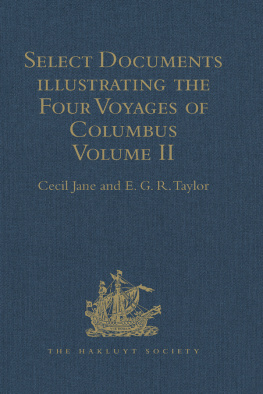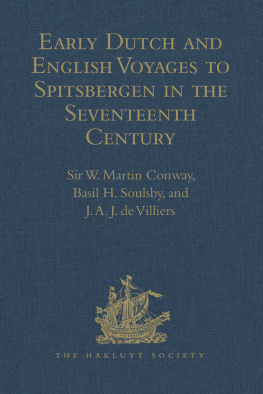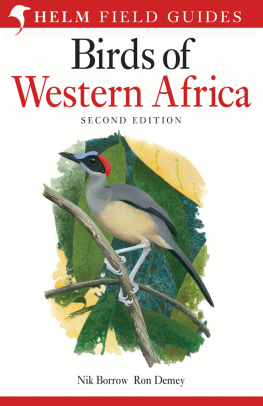First published by Ashgate Publishing
Published 2016 by Routledge
2 Park Square, Milton Park, Abingdon, Oxon OX14 4RN
711 Third Avenue, New York, NY 10017, USA
Routledge is an imprint of the Taylor & Francis Group, an informa business
All rights reserved. No part of this book may be reprinted or reproduced or utilised in any form or by any electronic, mechanical, or other means, now known or hereafter invented, including photocopying and recording, or in any information storage or retrieval system, without permission in writing from the publishers.
Notice:
Product or corporate names may be trademarks or registered trademarks, and are used only for identification and explanation without intent to infringe.
Founded in 1846, the Hakluyt Society seeks to advance knowledge and education by the publication of scholarly editions of primary records of voyages, travels and other geographical material. In partnership with Ashgate, and using print-on-demand and e-book technology, the Society has made re-available all 290 volumes comprised in Series I and Series II of its publications in both print and digital editions. For information about the Hakluyt Society visit www.hakluyt.com .
ISBN 13: 978-1-4094-1447-6 (hbk)
WOEKS ISSUED BY
The Hakluyt Society
THE VOYAGES OF CADAMOSTO
SECOND SERIES
No. LXXX
ISSUED FOR 1937
COUNCIL OF THE HAKLUYT SOCIETY 1937
SIR WILLIAM FOSTER, C.I.E., President.
THE RIGHT HON. THE EARL BALDWIN OF BEWDLEY, K.G., Vice-President.
ADMIRAL SIR WILLIAM GOODENOUGH, G.C.B., M.V.O., Vice-President,
JAMES A. WILLIAMSON, ESQ.. D.LIT., Vice-President.
E. W. BOVILL, ESQ.
SIR RICHARD BURN, C.S.I.
G. R. CRONE, ESQ.
VICE-ADMIRAL SIR PERCY DOUGLAS, K.C.B., C.M.G.
E. W. GILBERT, ESQ., B.LITT.
VINCENT T. HARLOW, ESQ., D.LITT.
A. R. HINES, ESQ., C.B.E., F.R.S.
T. A. JOYCE, ESQ., O.B.E.
MALCOLM LETTS, ESQ.
PROF. A. P. NEWTON, D.LIT.
N. M. PENZER, ESQ.
PROF. EDGAR PRESTAGE, D.LITT.
S. T. SHEPPARD, ESQ.
BRIGADIER-GENERAL SIR PERCY SYKES, K.C.I.E., C.B., C.M.G.
ROLAND V. VERNON, ESQ., C.B.
R. A. WILSON, ESQ.
EDWARD HEAWOOD, ESQ., Treasurer.
EDWARD LYNAM, ESQ., M.R.I.A., Hon. Secretary (British Museum, W.C.).
THE VOYAGES OF CADAMOSTO
AND OTHER DOCUMENTS ON WESTERN AFRICA IN THE SECOND HALF OF THE FIFTEENTH CENTURY
Translated and edited by
G. R. CRONE
LONDON
PRINTED FOR THE HAKLUYT SOCIETY
MCMXXXVII
T HE importance of Cadamostos narrative has long been recognized by students of African historical geography. It is clear, however, from a study of the literature, that considerable misconception is current concerning his achievements and the character of his work. This is largely due to the lack of a critical edition of the text, and of a modern translation. The sole English translation, in a condensed form, appeared in the middle of the eighteenth century.
It was thought appropriate to add to the present version translations of other documents comprising our authorities for this important period in Portuguese expansion, so that the volume might form a sequel to the edition of Azuraras Chronicle by C. R. Beazley and Edgar Prestage (Hakluyt Soc., Ser. I, vols. xcv and c).
Without the assistance received from others, I should not have been able to carry through the task of editorship. In particular I am much indebted to Mr E. W. Bovill, who has co-operated throughout. He is the author of the first section of the Introduction, and of a number of footnotes. Indeed, it is at his wish alone that his name does not appear on the title-page as co-editor. I am also grateful to Professor Edgar Prestage for his generous advice and help; and to Senhor Armando Corteso for considerable assistance in translating the extracts from Barros. As all editors of volumes for the Hakluyt Society will appreciate, Mr Edward Lynam, the Honorary Secretary, has rendered me many kindnesses throughout.
G. R. CRONE
June 1937
I
The trade between the Western Sudan and the Mediterranean
T HE course of the Portuguese exploration of the western coast of Africa has been narrated by Sir Raymond Beazley and Professor Prestage in their introduction to the Hakluyt Society edition of Azuraras Chronicle of the Discovery and Conquest of Guinea1, although that work ends approximately at the year 1448. The documents printed in the present volume carry on the narrative from that date until the closing years of the century, and in this introduction emphasis will be laid upon the relations between these coastal voyages and the trade of the interior, which had been highly organized on well-defined routes for a considerable period before the beginning of Portuguese expansion.
Throughout the Middle Ages there had been a thriving trade between the Christians of Europe and the Moslems of the Maghreb, as they called North Africa. Christian galleys were constantly putting in and out of a dozen or more African ports, of which Massa, Saffi, Salee and Tangier on the Atlantic, and Honein, Algiers, Bone and Tunis on the Mediterranean, were the most important. The Normans of Sicily had been amongst the first in the field, but later the Pisans, Genoese, Marseillais and Venetians acquired their respective rights and privileges along the Barbary coast. Each nation had negotiated treaties to protect its nationals and its interests, and maintained a consul and a fonduk in the ports with which it traded. So firmly was this trade established that it was seldom interrupted by the scourge of piracya constant source of international friction, in which Christians, more often than Moslems, seem to have been the aggressors.
In spite of their consuls and their fonduks, the Christians were rigorously excluded from the interior. Occasionally an enterprising merchant might penetrate as far as Marrakech, Constantine or Kairwan, but here his treaty rights gave him no protection against the middlemen who jealously guarded their control over the trade of the interior against the interference of interlopers. Consequently there was a marked contrast between the extraordinary journeys of Europeans in Asia and their complete ignorance of the interior of northern Africa, although they had long known it to be a region of great commercial activity.














